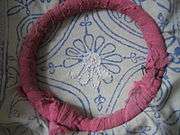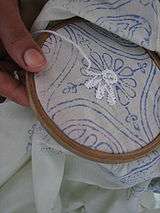Chikan (embroidery)

Chikan (Hindi: चिकन, Urdu: چکن) is a traditional embroidery style from Lucknow, India. Literally translated, the word means embroidery. Believed to have been introduced by Nur Jehan, the wife of Mughal emperor Jahangir,[1] it is one of Lucknow's best known textile decoration styles. The market for local chikan is mainly in Chowk, Lucknow.
Origin
There are several theories about the origin of chikan. The process of chikan was basically invented in Lucknow. It developed quickly during the period when the Mughals ruled and consisted of styles inspired by foreigners. Lucknow grew into an international market for its renowned chikan work.
There are references to Indian chikan work as early as 3rd century BC by Megasthenes, who mentioned the use of flowered muslins by Indians. There is also a tale that mentions how a traveler taught chikan to a peasant in return of water to drink. However, the Noor Jahan story is the most popular of the lot.[2]
Chikan began as a type of white-on-white (or whitework) embroidery.[3]
Technique
The technique of creation of a chikan work is known as chikankari (चिकनकारी چکن کاری). Chikan is a delicate and artfully done hand embroidery on a variety of textile fabric like muslin, silk, chiffon, organza, net, etc. White thread is embroidered on cool, pastel shades of light muslin and cotton garments. Nowadays chikan embroidery is also done with coloured and silk threads in colours to meet the fashion trends and keep chikankari up-to-date. Lucknow is the heart of the chikankari industry today and the variety is known as Lucknawi chikan.
Chikan work in the recent times has adapted additional embellishments like Mukaish, Kamdani, Badla, Kamdani, sequin, bead and mirror work, which gives it a rich look. Chikan embroidery is mostly done on fabrics like cotton, semi-Georgette, pure Georgette, crepe, chiffon, silk and any other fabric which is light and which highlights the embroidery. The fabric cannot be too thick or hard, else the embroidery needle won't pierce it.
The piece begins with one or more pattern blocks that are used to block-print a pattern on the ground fabric. The embroiderer stitches the pattern, and the finished piece is carefully washed to remove all traces of the printed pattern.[4] The process of chikankari includes following steps:
- Design
- Engraving
- Block printing
- Embroidery
- Washing and finishing
Stitches
The patterns and effects created depend on the stitches and the thicknesses of the threads used. Some of the stitches include backstitch, chain stitch and hemstitch. The result is an open work pattern, jali (lace) or shadow-work. Often the embroiderer creates mesh-like sections by using a needle to separate threads in the ground fabric, and then working around the spaces.[4] It consists of 32 stitches:[5]


- Tepchi is a long running or darning stitch worked with six strands on the right side of the fabric taken over four threads and picking up one. Thus, a line is formed. It is used principally as a basis for further stitchery and occasionally to form a simple shape.
- Bakhiya — ‘Shadow work’ or bhakia is one of the stitches of chikankari. The reason for the name shadow is that the embroidery is done on wrong side and we see its shadow on the right side.
- Hool is a fine detached eyelet stitch. A hole is punched in the fabric and the threads are teased apart. It is then held by small straight stitches all round and worked with one thread on the right side of the fabric. It can be worked with six threads and often forms the center of a flower.[6]
- Zanzeera
- Rahet
- Banarsi
- Khatau
- Phanda''
- Murri is the form of stitch used to embroider the centre of the flowers in chikan work motifs. They are typically French knots that are rice-shaped. Murri is the oldest and most sought-after form of chikankari. The use of this stitch is depleting due to a decrease in the artisans doing this embroidery.
- Jali stitch is one where the thread is never drawn through the fabric, ensuring that the back portion of the garment looks as impeccable as the front. The warp and weft threads are carefully drawn apart and minute buttonhole stitches are inserted into the cloth.
- Turpai
- Darzdari
- Pechani
- Bijli
- Ghaspatti
- Makra
- Kauri
- Hathkadi
- Banjkali
- Sazi
- Karan
- Kapkapi
- Madrazi
- Bulbul-chasm
- Taj Mahal
- Janjeera
- Kangan
- Dhania-patti
- Rozan
- Meharki
- Chanapatti
- Baalda
- Jora
- Keel kangan
- Bulbul
- Sidhaul
- Ghas ki patti
GI status
Geographical Indication Registry (GIR) accorded Geographical Indication (GI) status for chikankari in December 2008, which recognized Lucknow as an exclusive hub of chikankari.[7]
In popular culture
The 1986 Indian film Anjuman directed by Muzaffar Ali and starring Shabana Azmi and Farooq Shaikh is set in Lucknow and deals with issues of chikan workers.[8]
References
- ↑ Wilkinson-Weber, Clare M. (1999). 5. Skill and Knowledge in Fine Chikan Embroidery, Embroidering Lives: Women's Work and Skill in the Lucknow Embroidery Industry, pp. 12-13. State University of New York Press. ISBN 0-7914-4087-7.
- ↑ "Chikankari". Cultural India. Retrieved 2013-08-11.
- ↑ "White on White Chikankari". Dress365days. Retrieved 2013-08-11.
- 1 2 Dusenbury, Mary M. (2004). Flowers, Dragons and Pine Trees: Asian Textiles in the Spencer Museum of Art, p. 42. Hudson Hills Press. ISBN 1-55595-238-0.
- ↑ "Stitches in Chikankari". Hand-embroidery.com. Retrieved 2013-08-11.
- ↑ "There are 32 stitches in chikankari. 1)... - ADA Designer Chikan Studio | Facebook". www.facebook.com. Retrieved 2015-10-26.
- ↑ "Chikankari GI a step towards international branding". The Times of India. Jan 16, 2009. Retrieved 10 July 2013.
- ↑ Anuradha Dingwaney Needham; Rajeswari Sunder Rajan (28 December 2006). The Crisis of Secularism in India. Duke University Press. pp. 235–236. ISBN 0-8223-8841-3.
Further reading
- Romancing With Chikankari by Veena Singh
- Paine, Sheila (1989). Chikan embroidery: the floral whitework of India. Shire Publications. ISBN 0-7478-0009-X.
- Ashok Rai (1992). Chikankari Embrodery of Lucknow. National Institute of Design.
External links
| ||||||||||||||||||||||||||||||||||||


